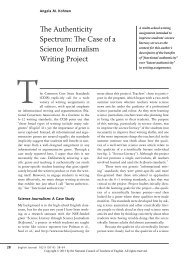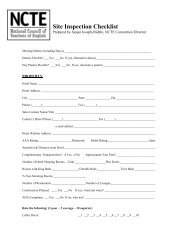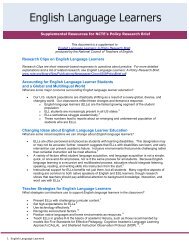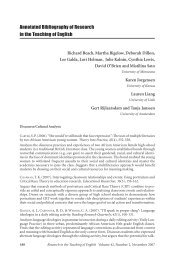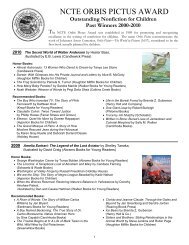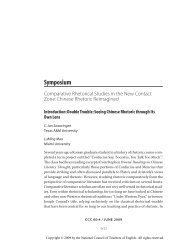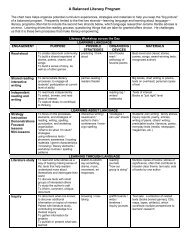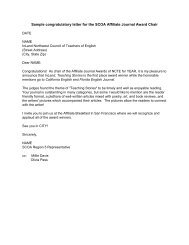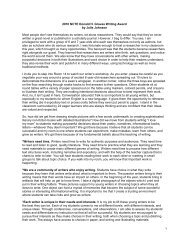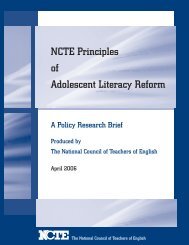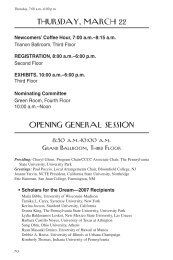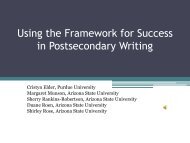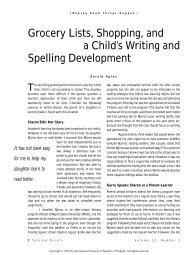<strong>Annotated</strong> <strong>Bibliography</strong> 239Explores whe<strong>the</strong>r <strong>the</strong> tra<strong>in</strong><strong>in</strong>g <strong>of</strong> l<strong>in</strong>guistic fluency improves <strong>the</strong> writ<strong>in</strong>g skills <strong>of</strong> elementaryschool students. Conditions were systematically varied on two dimensions: implicit versus explicit<strong>in</strong>struction and attention to forms versus attention to mean<strong>in</strong>g. As post-tests, writ<strong>in</strong>gtasks with vary<strong>in</strong>g degrees <strong>of</strong> translation freedom were used. F<strong>in</strong>ds that students <strong>in</strong> <strong>the</strong> experimentalgroups outperformed <strong>the</strong> control students on <strong>the</strong> less constra<strong>in</strong>ed writ<strong>in</strong>g task.O<strong>the</strong>r Related <strong>Research</strong>:ALTEMEIER, L., JONES, J., ABBOTT, R. D., & BERNINGER, V. W. (2006). Executive functions <strong>in</strong> becom<strong>in</strong>gwrit<strong>in</strong>g readers and read<strong>in</strong>g writers: Note-tak<strong>in</strong>g and report-writ<strong>in</strong>g <strong>in</strong> third and fifth graders.Developmental Neuropsychology, 29(1), 161-173.ANDREWS, R., TORGERSON, C., BEVERTON, S., FREEMAN, A., LOCKE, T., LOW, G., ROBINSON, A., ZHU, D.(2006). The effect <strong>of</strong> grammar teach<strong>in</strong>g on writ<strong>in</strong>g development. British Educational <strong>Research</strong>Journal, 32(1), 39-55.BALL, A., & LARDNER. T. (2005). African American literacies unleashed: Vernacular <strong>English</strong> and <strong>the</strong>composition classroom. Carbondale: Sou<strong>the</strong>rn Ill<strong>in</strong>ois University Press.BITCHENER, J., YOUNG, S., & CAMERON, D. (2005). The effect <strong>of</strong> different types <strong>of</strong> corrective feedbackon ESL student writ<strong>in</strong>g. Journal <strong>of</strong> Second Language Writ<strong>in</strong>g, 14(3), 191-205.BRENT, D. (2005). Re<strong>in</strong>vent<strong>in</strong>g WAC (aga<strong>in</strong>): The first-year sem<strong>in</strong>ar and academic literacy. CollegeComposition and Communication, 57(2), 253-276.BROWN, A. (2005). Self-assessment <strong>of</strong> writ<strong>in</strong>g <strong>in</strong> <strong>in</strong>dependent language learn<strong>in</strong>g programs: Thevalue <strong>of</strong> annotated samples. Assess<strong>in</strong>g Writ<strong>in</strong>g, 10(3), 174-191.CASTELLÓ, M., & MONEREO, C. (2005). Students’ note-tak<strong>in</strong>g as a knowledge-construction tool.L1-Educational Studies <strong>in</strong> Language and Literature, 5(3), 265-285.CUMMING, A., KANTOR, R., BABA, K., ERDOSY, U., EOUANZOUI, K., & JAMES, M. (2005). Differences <strong>in</strong>written discourse <strong>in</strong> <strong>in</strong>dependent and <strong>in</strong>tegrated prototype tasks for next generation TOEFL.Assess<strong>in</strong>g Writ<strong>in</strong>g, 10(1), 5-43.DEATLINE-BUCHMAN, A., & JITENDRA, A. K. (2006). Enhanc<strong>in</strong>g argumentative essay writ<strong>in</strong>g <strong>of</strong> fourthgradestudents with learn<strong>in</strong>g disabilities. Learn<strong>in</strong>g Disability Quarterly, 29(1), 39-54.DE LARIOS, J. R., MANCHON, R. M., & MURPHY, L. (2006). Generat<strong>in</strong>g text <strong>in</strong> native and foreignlanguage writ<strong>in</strong>g: A temporal analysis <strong>of</strong> problem-solv<strong>in</strong>g formulation processes. The ModernLanguage Journal, 90(1), 100-114.EBEST, S. B. (2006). Chang<strong>in</strong>g <strong>the</strong> way we teach: Writ<strong>in</strong>g and <strong>the</strong> resistance <strong>in</strong> <strong>the</strong> tra<strong>in</strong><strong>in</strong>g <strong>of</strong> teach<strong>in</strong>gassistants. Carbondale: Sou<strong>the</strong>rn Ill<strong>in</strong>ois University Press.ERICSSON, P. F., & HASWELL, R. (EDS.). (2006). Mach<strong>in</strong>e scor<strong>in</strong>g <strong>of</strong> student essays: Truth and consequences.Logan: Utah State University Press.FOSTER, D. (2006). Writ<strong>in</strong>g with authority: Students’ roles as writers <strong>in</strong> cross-national perspective.Carbondale: Sou<strong>the</strong>rn Ill<strong>in</strong>ois University Press.GRAHAM, S., HARRIS, K. R., & MACARTHUR, C. (2006). Explicitly teach<strong>in</strong>g struggl<strong>in</strong>g writers: Strategiesfor master<strong>in</strong>g <strong>the</strong> writ<strong>in</strong>g process. Intervention <strong>in</strong> School and Cl<strong>in</strong>ic, 41(5), 290-294.HAYES, J. R., & CHENOWETH, N. A. (2005). Is work<strong>in</strong>g memory <strong>in</strong>volved <strong>in</strong> <strong>the</strong> transcrib<strong>in</strong>g andedit<strong>in</strong>g <strong>of</strong> texts? Written Communication, 23(2), 135-149.HOEFFLIN, G., & FRANCK, J. (2005). Development <strong>of</strong> spell<strong>in</strong>g skills <strong>in</strong> children with and withoutlearn<strong>in</strong>g disabilities. L1 – Educational Studies <strong>in</strong> Language and Literature, 5(2), 175-192.HOHENSHELL, L. M., & HAND, B. (2006). Writ<strong>in</strong>g-to-learn strategies <strong>in</strong> secondary school cell biology:A mixed method study. International Journal <strong>of</strong> Science Education, 28(2-3), 261-289.HOROWITZ, R. (ED.). (2006). Talk<strong>in</strong>g texts: How speech and writ<strong>in</strong>g <strong>in</strong>teract <strong>in</strong> school learn<strong>in</strong>g.Mahwah, NJ: Erlbaum.HUNTER, D., MAYENGA, C., & GAMBELL, T. (2006). Classroom assessment tools and uses: Canadian<strong>English</strong> teachers’ practices for writ<strong>in</strong>g. Assess<strong>in</strong>g Writ<strong>in</strong>g, 11(1), 42-65.
240 <strong>Research</strong> <strong>in</strong> <strong>the</strong> Teach<strong>in</strong>g <strong>of</strong> <strong>English</strong> Volume 41 November 2006KIEFT, M., RIJLAARSDAM, G., & VAN DEN BERGH, H. (2006). Writ<strong>in</strong>g as a learn<strong>in</strong>g tool: Test<strong>in</strong>g <strong>the</strong>role <strong>of</strong> students’ writ<strong>in</strong>g strategies. European Journal <strong>of</strong> Psychology <strong>of</strong> Education 21(1), 17-34.KORAT, O., & SCHIFF, R. (2005). Do children who read more books know “what is good writ<strong>in</strong>g”better than children who read less? A comparison between grade levels and SES groups. Journal<strong>of</strong> Literacy <strong>Research</strong>, 37(3), 289-324.KLEIN, J., & TAUB, D. (2005). The effect <strong>of</strong> variations <strong>in</strong> handwrit<strong>in</strong>g and pr<strong>in</strong>t on evaluation <strong>of</strong>student essays. Assess<strong>in</strong>g Writ<strong>in</strong>g, 10(2), 134-148.LEFRANÇOIS, P. (2005). How do university students solve l<strong>in</strong>guistic problems? A description <strong>of</strong><strong>the</strong> processes lead<strong>in</strong>g to errors. L1 – Educational Studies <strong>in</strong> Language and Literature, 5(3), 417-432.LILLIS, T., & CURRY, M. J. (2006). Pr<strong>of</strong>essional academic writ<strong>in</strong>g by multil<strong>in</strong>gual scholars: Interactionswith literacy brokers <strong>in</strong> <strong>the</strong> production <strong>of</strong> <strong>English</strong>-medium texts. Written Communication,23(1), 3-35.LIU, K. M. (2006). Annotation as an <strong>in</strong>dex to critical writ<strong>in</strong>g. Urban Education, 41(2), 192-207.LUCE-KAPLER, R., & KLINGER, D. (2005). Uneasy writ<strong>in</strong>g: The def<strong>in</strong><strong>in</strong>g moments <strong>of</strong> high-stakesliteracy test<strong>in</strong>g. Assess<strong>in</strong>g Writ<strong>in</strong>g, 10(3), 157-173.LUMLEY, T. (2005). Assess<strong>in</strong>g second language writ<strong>in</strong>g: The rater’s perspective. New York: PeterLang.MARTIN, L., SEGRAVES, R., THACKER, S., & YOUNG, L. (2005). The writ<strong>in</strong>g process: Three first-gradeteachers and <strong>the</strong>ir students reflect on what was learned. Read<strong>in</strong>g Psychology, 26(3), 235-249.MERISUO-STORM, T. (2006). Girls and boys like to read and write different texts. Scand<strong>in</strong>avianJournal <strong>of</strong> Educational <strong>Research</strong>, 50(2), 111-125.MILIAN, M. (2005). Reformulation: A means <strong>of</strong> construct<strong>in</strong>g knowledge <strong>in</strong> shared writ<strong>in</strong>g. L1 –Educational Studies <strong>in</strong> Language and Literature, 5(3), 335-351.MONTÉSINOS-GELET, I., & MORIN, M. F. (2005). The impact <strong>of</strong> a cooperative approximate spell<strong>in</strong>gsituation <strong>in</strong> a k<strong>in</strong>dergarten sett<strong>in</strong>g. L1 – Educational Studies <strong>in</strong> Language and Literature, 5(3),365-383.MORIN, M. F. (2006). Declared knowledge <strong>of</strong> beg<strong>in</strong>n<strong>in</strong>g writers. L1 – Educational Studies <strong>in</strong> Languageand Literature, 5(3), 385-401.NEUWIRTH, C., VAN WAES, L., & LEIJTEN, M. (EDS.) (2006). Writ<strong>in</strong>g and digital media (Studies <strong>in</strong>writ<strong>in</strong>g: Vol. 17). Oxford, UK: Elsevier.RIJLAARSDAM, G., COUZIJN, M., JANSSEN, T., BRAAKSMA, M., & KIEFT, M. (2006). Writ<strong>in</strong>g experimentmanuals <strong>in</strong> science education: The impact <strong>of</strong> writ<strong>in</strong>g, genre, and audience. International Journal<strong>of</strong> Science Education, 28(2-3), 203-233.SHIPKA, J. (2005). A multimodal task-based framework for compos<strong>in</strong>g. College Composition andCommunication, 57(2), 277-306.SMAGORINSKY, P. (ED.). (2005). <strong>Research</strong> on composition: Multiple perspectives on two decades <strong>of</strong>change. New York: Teachers College Press.SYRQUIN, A. F. (2006). Registers <strong>in</strong> <strong>the</strong> academic writ<strong>in</strong>g <strong>of</strong> African American college students.Written Communication, 23(1), 63-90.THAISS, C., & ZAWACKI, T. M. (2006). Engaged writers and dynamic discipl<strong>in</strong>es: <strong>Research</strong> on <strong>the</strong>academic writ<strong>in</strong>g life. Portsmouth, NH: Boynton/Cook.VAN DEN BERG, I., ADMIRAAL, W., & PILOT, A. (2006). Design pr<strong>in</strong>ciples and outcomes <strong>of</strong> peerassessment <strong>in</strong> higher education. Studies <strong>in</strong> Higher Education, 31(3), 341-356.VAN WAES, L., LEIJTEN, M., & NEUWIRTH, C. (EDS.). (2006). Writ<strong>in</strong>g and digital media. New York:Elsevier.VANHULLE, S. (2005). How future teachers develop pr<strong>of</strong>essional knowledge through reflectivewrit<strong>in</strong>g <strong>in</strong> a dialogical frame. L1 – Educational Studies <strong>in</strong> Language and Literature, 5(3), 287-314.



